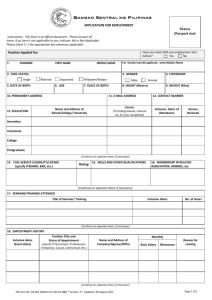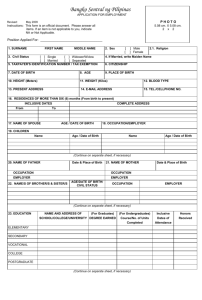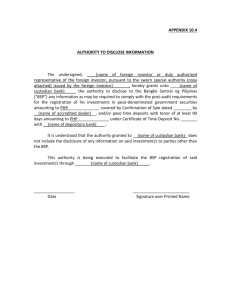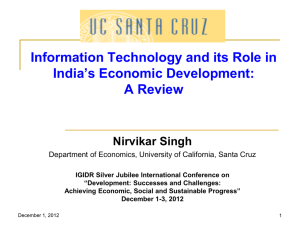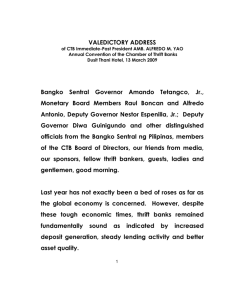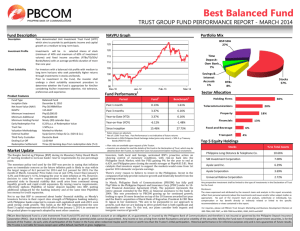Measuring the Contribution to the Philippine Economy of Information
advertisement
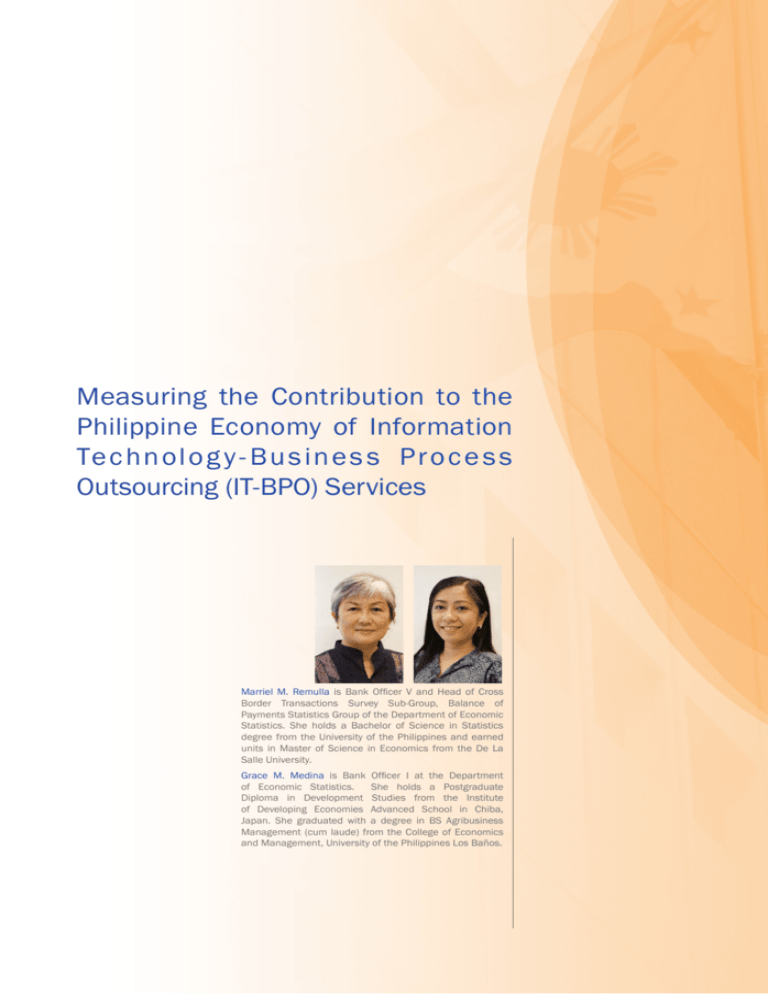
Measuring the Contribution to the Philippine Economy of Information Te c hnolog y - Bu sine s s Pro c e s s Outsourcing (IT-BPO) Services Marriel M. Remulla is Bank Officer V and Head of Cross Border Transactions Survey Sub-Group, Balance of Payments Statistics Group of the Department of Economic Statistics. She holds a Bachelor of Science in Statistics degree from the University of the Philippines and earned units in Master of Science in Economics from the De La Salle University. Bangko Sentral Review 2012 Grace M. Medina is Bank Officer I at the Department of Economic Statistics. She holds a Postgraduate Diploma in Development Studies from the Institute of Developing Economies Advanced School in Chiba, Japan. She graduated with a degree in BS Agribusiness Management (cum laude) from the College of Economics and Management, University of the Philippines Los Baños. 1 Introduction The expansion in the services sector during the past decade has been largely influenced by the rapid development in the information and communication technology (ICT) services, notably in contact centers and other business process outsourcing (BPO). Recognizing the industry’s contribution to employment generation, investments and foreign exchange earnings, and given the comparative advantage of the country’s workforce in these type of services, the government’s thrust to promote the development of ICTBPO services was articulated in the Philippine Development Plan (PDP) 2005-2010 and its successor, PDP 2011-2016. Government support to the industry is seen to increase, with the Philippines emerging as the “primary destination of choice for voice services and the second most preferred destination for Information Technology-Business Process Outsourcing (IT-BPO) and global in-house center (GIC) complex, non-voice services after India.” This is affirmed by the announcement of Everest Research in January 2011 that the Philippines surpassed India as the number one voice services center in the world with US$ 5.7 billion in revenues, compared to India’s US$ 5.5 billion in 2010 (BPA/P, 2011). On the part of the private sector, the Philippine IT-BPO Road Map 2011-2016 identified five priority activities in order for the Business Processing Association of the Philippines (BPA/P) to support the expansion and development of the IT-BPO industry. These priority activities include: 1. upgrading standards and accreditation to ensure a better match between the skills of graduates with the requirements of the industry; 2. marketing the industry more aggressively to the local talent pool; 3. strengthening awareness of the country’s competitive edge in IT, voice and non-voice BPO services in existing and new markets; Bangko Sentral Review 2012 4. advocating high-impact public policies; and 2 5. strengthening BPA/P’s Public-Private Partnership with government to fund key programs such as study-to-work training programs (BPA/P, 2012).1 1 The Philippine IT-BPO Road Map 2011-2016 was developed through a joint venture between Everest Group and Outsource2Philippines in close coordination with the Business Processing Association of the Philippines (BPA/P), the umbrella association for the IT-BPO and GIC (Global In-House Center) industry in the country, in consultation with BPA/P’s partner associations and key government officials and various executives representing enabling sectors such as telecom, training and recruitment, and real estate management. Toward monitoring the progress and impact of government and private initiatives in support of the industry, and for more informed policy decisions by the government, the country’s generation of a comprehensive, reliable, frequent and timely statistics is crucial. This paper presents the data initiatives undertaken by the Philippine Statistical System (PSS), in particular by the Bangko Sentral ng Pilipinas (BSP), to support the demand for ICT-BPO services statistics, which has grown over the years. The paper will also present future directions to enhance the industry’s database that will adequately monitor the developments and emerging trends in the industry, and to institutionalize the generation of ICT-BPO services statistics by an appropriate agency. The Survey of IT-BPO Services Background The Survey of IT-BPO Services (formerly IT and IT-Enabled Services until 2008) started as an initiative of the Inter-Agency Committee on Trade Statistics (IAC-TrS) to provide reliable statistics on the contribution of the industry to the Philippine economy.2 The BSP, in close coordination with the members of the IAC-TrS and the industry associations, spearheaded the conduct of the 2005 benchmark survey in April 2006, the results of which were released in May 2007. With information support from the Philippine Export Zone Authority (PEZA) and the Board of Investments (BOI), it has continued to conduct the annual surveys, while the envisioned institutionalization has yet to materialize.3 Survey Coverage The survey respondents included companies engaged in the operations of contact centers, medical and legal transcription, animation, software development and other BPO activities. The following highlights the coverage of each category: Contact Center - Answering and transmitting calls from clients by using human operators, automatic distribution, computer telephone integration, interactive voice response systems or similar methods to receive orders, provide information, deal with customer requests for assistance or address customer complaints, debt collection, collective handling of letters, fax messages, e-mails, postal mail catalogues, website inquiries and chats, and the collection of information from customers during in-store purchasing. Transcription Activities - Transfer of data from one form (voice/oral) to another (paper or electronic) such as medical history, diagnosis, prognosis and outcome, depositions, hearing and court tapes; data entry services; and scanning of documents. The IAC-TrS is comprised of the Department of Trade and Industry (DTI), National Statistical Coordination Board (NSCB), National Statistics Office (NSO), National Economic and Development Authority (NEDA) and the Bangko Sentral ng Pilipinas (BSP). 3 The Monetary Board (MB), pursuant to MB Resolution No. 1054 dated 14 August 2008, approved the Memorandum of Agreement (MOA) on the exchange of data of companies engaged in IT and IT-enabled services between the BSP and the Department of Trade and Industry (DTI), through its attached agencies, namely, BOI and PEZA. The MOA is expected to improve, over the medium term, the data capture and measurement of the BPO industry’s contribution to the economy. 2 Bangko Sentral Review 2012 3 Animation - Process of giving the illusion of movement to cinematographic drawings, models, or inanimate objects thru 2D, 3D, or other similar technology; includes 2D animation from layouts to final composing, digital ink and paint service, 3D animation using the latest software like Maya, XSI, 3DStudio Max, among others; pre-production services from storyboarding, character and production design, key backgrounds and layouts, 2D and 3D animation for games, flash animation for animated series (broadcast quality). Software Development/Publishing - This covers the following sub-categories: a. Software development - Analysis and design, prototyping, programming and testing, customization, reengineering and conversion, installation and maintenance, education and training of systems software, middleware and application software, software development management; b. Software publishing - Production, supply and documentation of ready-made (non-customized) software, such as operating systems, business and other applications, computer games for all platforms; and c. Other software consultancy and supply - Development, production, supply and documentation of made-to-order software based on orders from specific users; web page design and software maintenance. Other BPOs - Include backroom operations, data processing, data base activities and online distribution of electronic content, and other value-added chain activities—shared financial and accounting services, outsourcing for research and public opinion polling, outsourcing for business and management consultancy activities, hardware consultancy and outsourcing for architectural and engineering services. Survey Methodology The sampling frame for the IT-BPO survey consists of member companies of the BPA/P, PEZA locators and BOI-registered companies. Questionnaires are sent through e-mail or post to BSP respondents, which are the BPA/P member companies. For companies under PEZA and BOI, submissions are part of the regulatory requirements for these locators. Their inputs are processed and consolidated based on the agreed format, then submitted to the BSP.4 Where companies are covered in both PEZA/BOI reports and the BSP survey, responses to the BSP survey are the ones encoded as these provide more details than those from the PEZA and BOI reports. Estimates for non-response are made based on the following estimation methodology: For each IT-BPO subsector: = no. of companies which responded to the BSP survey = no. of companies whose data were submitted to/available from BOI/ PEZA Bangko Sentral Review 2012 = no. of non-responding companies whose revenue data were taken from the SEC 4 = no. of non-responding companies for the reference year, whose data for the previous year are available 4 Starting with the 2009 Survey of IT-BPO services, a common survey form was agreed to be implemented by the BSP, PEZA and BOI to improve the reliability of the survey results. However, details on the country of export and source country of equity were excluded from PEZA and BOI respondents since these information are not available. = remaining no. of non-responding companies (including new entrants) Total number of companies = For revenue: = revenue of companies which responded to the survey = revenue of companies which did not submit survey data but which submitted revenue data to BOI/PEZA = revenue of companies which did not submit survey/BOI/PEZA data but whose revenue data are available from SEC = previous year’s revenue of companies falling under , multiplied by the average growth of responding companies with comparable data for the previous year, by IT category = in x average revenue (adjusted for outliers)5 of companies included and For exports: = exports of companies which responded to the survey = exports of companies which did not submit survey data but which submitted export data to BOI/PEZA For other variables: Total Equity: Foreign Investments: Employment: Compensation: Revenue data are considered outliers if they fall outside the range, i.e., value >/< mean+/- 2 standard deviations Bangko Sentral Review 2012 5 5 Survey Results Revenues The country’s IT-BPO industry continued to exhibit double-digit positive annual growth rates in revenues generated from 2004 to 2011. The industry posted US$12.1 billion of revenues in 2011, about nine times the US$1.3 billion level realized in 2004. Amid the global financial crisis experienced in 2007 to 2008, the local IT-BPO industry remained resilient, although growth in revenues was slightly lower compared to previous years. Top officials of different outsourcing companies and associations continued to be optimistic on the prospects of the industry, suggesting that multinational firms keep on outsourcing services to cheaper locations, including the Philippines, to cut costs. The growth in the industry’s revenues further declined in 2009 as most of the industry’s outsourcing clients were from the advanced economies, where recovery remained slow in the latter part of the year. This situation triggered the review and recalibration by IT-BPO companies and foreign investors of their business plans, which delayed, if not dampened, expansion in the industry. The industry’s growth over the years was due to the continued demand for offshore call or contact centers. According to the IBM’s Global Locations Trend, the Philippines ranked number one in the shared services and BPO categories in the world in 2010. The country overtook India as the contact center capital of the world, outperforming the latter in terms of revenue and employment generation.6 Figure 1 Bangko Sentral Review 2012 Revenue, by Category, 2004-2011 (in US$ million) 6 The Philippines is a favored BPO location due to its workforce, armed with good English conversational skills as well as deeper understanding and appreciation of the Western culture. The multilingual skills of the Filipinos also add to the country’s competitive edge as many call center outsourcing firms in the country capitalize on the multilingual Filipino workforce to serve the Hispanic, Japanese and European population. Contact Centers remained the biggest contributor in terms of revenues for the years covered by the survey. The sector’s contribution to the industry’s total revenues has increased from 44.4 percent (or US$5.9 billion) in 2004 to 56.5 percent (or US$6.8 billion) in 2010. Other BPOs and Software Development consistently followed as second and third largest contributors, respectively, except in 2006, when Software Development took the spot of Other BPOs. The latest survey in 2011 showed that Other BPOs and Software Development accounted for 21.5 percent and 20.4 percent, respectively. 6 The Philippine call center industry employed about 350,000 compared to India’s 330,000; and generated revenues of US$6.3 billion vis-a-vis India’s US$5.9 billion. Table 1 Revenue Percent Share to Total, By Category, 2004-2011 IT-BPO Category 2004 2005 2006 2007 2008 2009 2010 2011 Contact Center 44.4 49.4 50.1 46.9 44.9 50.9 52.3 56.5 Transcription 0.3 0.4 0.7 0.7 0.5 0.7 0.8 1.0 Animation 0.9 0.9 0.9 0.7 0.6 0.6 0.6 0.6 Software Development 21.1 20.0 24.3 25.1 22.3 20.3 21.9 20.4 Other BPOs 33.3 29.3 24.0 26.5 31.7 27.5 24.4 21.5 TOTAL INDUSTRY 100.0 100.0 100.0 100.0 100.0 100.0 100.0 100.0 Over the years, all sub-sectors of the IT-BPO industry recorded expansions in revenues generated. Transcription activities consistently recorded the highest growth rate, except in 2007 and 2008 when Other BPOs took the lead in terms of growth rates. This development showed the shift of the local outsourcing industry towards more value-added chain activities such as financial, research and consultancy services, which are covered under the “Other BPOs” category. The marked slowdown in revenue growth in Transcription, which expanded by only 4.1 percent in 2008 from 60.6 percent in 2007, was the result of the transfer of some foreign clients from the Philippines to other transcription service-providing countries to trim down costs at the height of the financial turmoil. The Transcription and Animation categories, however, posted dynamic growth in revenues in 2009 due to the expansion of transcription companies and the release of more local animation films in the country. Meanwhile, growth in Other BPOs fell sharply during the same year as many of the companies reduced their charges to retain their clients while others received less job orders, especially from advanced economies. Table 2 Revenue Growth Rates, By Category, 2005-2011 (in percent) IT-BPO Category Contact Center 2005 2006 2007 2008 2009 2010 2011 67.9 47.7 40.9 38.4 48.2 25.0 29.6 100.4 140.0 60.6 4.1 66.8 48.8 44.3 Animation 37.6 52.6 11.2 25.5 44.2 20.6 14.0 Software Development 43.2 77.1 55.4 28.6 18.4 31.4 12.3 Other BPOs 32.8 19.1 66.0 73.2 13.3 8.0 5.8 TOTAL INDUSTRY 50.8 45.6 50.3 44.8 30.6 21.8 20.1 Transcription Contact Centers were the key driver of growth of the IT-BPO industry, except in 2008 when the Other BPOs had the biggest contribution to growth at 19.4 percentage points compared to Contact Centers’ 18 percentage points contribution to the total 44.8 percent year-on-year rise in revenues of the industry. Table 3 Percentage-Point Contribution to Growth in Revenues, 2005-2011 2005 2006 2007 2008 2009 2010 2011 Contact Center 30.1 23.5 20.5 18.0 21.6 12.8 15.5 Transcription 0.3 0.6 0.4 0.0 0.4 0.3 0.4 Animation 0.4 0.4 0.1 0.2 0.3 0.1 0.1 Software Development 9.1 15.4 13.5 7.2 4.1 6.4 2.7 Other BPOs 10.9 5.6 15.8 19.4 4.2 2.2 1.4 TOTAL INDUSTRY 50.8 45.6 50.3 44.8 30.6 21.8 20.1 Bangko Sentral Review 2012 IT-BPO Category 7 Exports Total export earnings of the IT-BPO industry were estimated at US$11.2 billion in 2011, more than twelve times the US$0.9 billion recorded in 2004. The industry’s exports remained on the uptrend since 2004, although at a decelerating rate since 2006. Exports continued to be robust despite the global economic crisis experienced in 2007-2008. Figure 2 In terms of contribution to growth, Contact Centers sustained top position among all sub-categories of the industry. Based on the latest survey, it accounted for the highest contribution at 15.4 percentage points to the 22.7 percent growth of the industry. The second largest contributor was Software Development, except in 2008-2009 when Other BPOs placed second. Exports, by Category, 2004-2011 (in US$ million) Table 4 Percentage-Point Contribution to Growth in Exports, 2005-2011 IT-BPO Category 2005 2006 2007 2008 2009 2010 2011 Contact Center 43.7 27.4 17.6 21.7 27.4 15.4 11.0 Transcription 0.5 0.8 0.3 (0.0) 0.6 0.3 0.5 Animation 0.4 0.8 0.2 0.2 0.2 0.1 0.1 Software Development 6.9 21.3 17.3 8.5 7.6 4.9 4.8 Other BPOs 4.7 14.6 17.2 21.1 10.1 2.1 1.5 TOTAL INDUSTRY 56.3 64.9 52.5 51.5 45.9 22.7 17.8 An increasing trend was observed in the total industry’s export-to-revenue ratio, from 67.1 percent in 2004 to 94.2 percent in 2010, but it slightly declined in 2011. The sustained growth of the industry’s exports reflected stronger global demand for shared services and business process outsourcing. Notable increases in export-to-revenue ratios were exhibited by Software Development (35.3 percent in 2004 to 96.4 percent in 2010) and Other BPOs (49.1 percent in 2004 to 93.7 percent in 2011). Table 5 Export-to-Revenue Ratio, By Category, 2004-2011 (in percent) Bangko Sentral Review 2012 IT-BPO Category 8 2004 2005 2006 2007 Contact Center 95.6 Transcription 100.0 2008 2009 96.3 91.4 99.5 92.9 2010 2011 84.5 87.7 93.6 97.4 90.4 77.1 70.5 96.1 89.0 100.0 Animation 62.4 66.4 87.3 91.9 95.8 87.1 85.0 83.1 Software Development 35.3 40.1 64.3 77.5 81.3 92.9 87.7 96.4 Other BPOs 49.1 44.2 66.2 73.9 79.4 93.7 93.3 93.7 TOTAL INDUSTRY 67.1 69.5 78.7 79.9 83.6 93.4 94.2 92.4 Table 6 Foreign Direct Investments in the IT-BPO Industry, By Country of Investor, 2005-2011 Percent Share to Total Equity 2005 2006 Percent Share to Total 2007 2008 2009 2010 2011 86.0 81.0 73.2 67.6 73.1 80.0 76.4 7.1 10.1 9.6 9.0 6.9 9.9 10.9 Japan 3.2 3.2 9.6 16.2 14.3 3.6 3.8 Australia-New Zealand 1.3 0.7 0.5 1.1 3.3 2.0 5.1 Others 2.4 5.0 7.1 6.0 2.4 4.5 3.9 100.0 100.0 100.0 100.0 100.0 100.0 100.0 Source Country USA Europe TOTAL INDUSTRY The United States has been the top export market for the country’s IT-BPO industry since 2004, accounting for 76.4 percent (or US$8.5 billion) of the industry’s total exports in 2011. Other major export markets were Europe, Japan and Australia-New Zealand. Equity Capital Investments7 Equity capital investments in the IT-BPO industry have expanded since 2005. These summed up to US$5.7 billion as of end-2011, almost 12 times the level recorded in end-2005. As of end-2008, the level of equity capital investments in the entire industry amounted to US$2 billion, more than twice the level recorded at end-2007. This developed as many IT business parks or “cyberparks” were completed or were being developed during the period, such as Megaworld’s Fort Cyberpark, UP-Ayala Technohub, Asiatown IT Park in Cebu, and One Asia’s IT Park in Biñan, Laguna, to cater to the expanding outsourcing business in the country. A marked increase in the level of investments was recorded in 2010, supported by a more favorable investment climate owing to the country’s strong macroeconomic fundamentals and growth prospects. Figure 3 7 Total Equity Capital Investments, 2005-2011 (in US$ million and percent share) Refers to the sum of the following: paid-up capital, additional paid-in capital/capital in excess of par value/paid-in surplus, appraisal surplus, retained earnings and other capital, less cost of stocks held in treasury, as of end-calendar year. For branches of foreign companies, it covers head office/home office account. Bangko Sentral Review 2012 The share of foreign equity participation (or US$0.3 billion) continuously increased from 66.9 percent of total equity capital investments in the industry in 2005 to 93.2 percent (or US$5.4 billion) in 2011. Despite the global economic crisis, foreign equity capital participation more than doubled at end-2007 and end-2008 as acquisitions by foreign investors and expansions of foreign firms were extensive during the period. 9 Transcription (in 2007 and 2008) and Animation (in 2008) increased their foreign equity participation to full ownership, buoyed up by investor confidence in the country as an attractive outsourcing destination due to the country’s good manpower skills. During the period, some animation companies also opted to be absorbed by their foreign clients due to issues of confidentiality and piracy. Table 7 Foreign-to-Foreign Total Equity Capital Ratio, By Category, 2005-2011 (in percent) IT-BPO Category 2005 2006 2007 Contact Center 87.6 92.0 98.1 Transcription 52.5 71.0 100.0 2008 2009 2010 2011 96.5 95.9 99.7 98.2 100.0 84.1 92.0 97.2 Animation 38.4 95.8 97.2 100.0 63.3 70.9 72.5 Software Development 37.0 73.9 50.9 84.6 99.4 94.8 95.4 Other BPOs 47.5 23.2 93.1 85.6 74.2 97.7 80.4 TOTAL INDUSTRY 66.9 60.4 87.9 93.3 91.8 97.6 93.2 The US was the largest foreign direct investor in the Philippine IT-BPO industry from 2005 to 2010, consistently capturing more than half of the industry’s total foreign equity capital investments. However, as of end-2011, Europe surpassed the US as the largest foreign equity capital investor in the country’s IT-BPO services industry. Another big source of foreign investments in the industry was Japan. Table 8 Foreign-to-Total Equity Capital Ratio, By Category, 2005-2011 (in percent) Country of Investor 2005 2006 2007 USA 67.3 71.5 54.2 Europe 22.1 5.9 23.5 Japan 1.4 21.5 51.2 Others 9.1 1.1 (28.9) 100.0 100.0 100.0 TOTAL INDUSTRY 2008 2009 2010 2011 54.0 57.2 71.8 38.5 18.6 31.8 7.3 46.2 20.0 8.9 16.8 9.0 7.4 2.1 4.1 6.4 100.0 100.0 100.0 100.0 Bangko Sentral Review 2012 Employment and Compensation 10 The IT-BPO industry continued to be a major source of employment for the country. Total employment in the industry in 2011 at 679,464 was more than seven times the 94,488 employed in 2004. Double-digit growth in employment was recorded since 2005, except in 2007 when a sharp slowdown was observed, but which was followed by a dramatic recovery the following year. The acceleration of growth in 2008 was due to the additional demand for employees from the newly opened cyberparks, supported by the increased supply of more qualified IT manpower that was a by-product of government scholarship programs. In 2010, the number of IT-BPO companies expanded in the Next Wave Cities located in Clark, Subic, Tarlac, and San Fernando, Pampanga which created more jobs. Linkages between industry associations and the academe were also established to ensure steady supply of quality manpower. Figure 4 Contact Centers consistently Employment by Category, 2004-2011 (in number of persons) absorbed more than half of the industry’s employment from 2004 to 2011, followed by Other BPOs and Software Development. By 2010, the Philippines already dislodged India as the largest contact center hub in the world. Contact centers located in India also expanded their operations in the Philippines and tapped the local workforce to meet the demand of global clients. In 2011, Contact Centers in the Philippines accounted for 63.8 percent of the industry’s total employment. Contact Centers continued to account for the biggest share of the industry’s employment. Table 9 Employment Percent Share to Total, By Category, 2004-2011 IT-BPO Category 2004 2005 2006 2007 2008 2009 2010 2011 Contact Center 68.8 69.7 62.0 62.5 59.8 57.5 61.5 63.8 Transcription 1.0 1.3 2.0 2.4 1.2 1.6 1.7 1.6 Animation 1.6 1.4 1.8 1.6 1.6 0.8 0.7 0.6 Software Development 12.7 12.9 17.2 16.5 14.0 10.6 9.2 8.2 Other BPOs 16.0 14.7 17.0 16.9 23.3 29.5 26.9 25.9 TOTAL INDUSTRY 100.0 100.0 100.0 100.0 100.0 100.0 100.0 100.0 Contact Centers and Other BPOs registered positive employment growth rates from 2005 to 2011. In 2009, Animation and Software Development posted declines of 34 percent and 5.8 percent, respectively, as professional animators from local companies were recruited by animation companies abroad and software development firms continued with their personnel rationalization as a means of cost saving. Table 10 Employment Growth Rates, By Category, 2005-2011 IT-BPO Category 2005 2006 2007 2008 2009 2010 2011 Contact Center 48.1 59.7 10.5 25.1 20.4 28.9 31.4 Transcription 98.1 177.7 33.6 (34.7) 63.4 29.3 21.4 Animation 25.3 140.4 (3.5) 30.8 (34.0) 4.7 1.6 12.0 Software Development 48.9 139.3 5.2 11.2 (5.8) 5.4 Other BPOs 34.1 108.4 8.8 80.2 58.4 9.7 22.1 TOTAL INDUSTRY 46.1 79.7 9.5 30.8 25.3 20.5 26.7 Bangko Sentral Review 2012 In terms of contribution to the growth in the industry’s employment, Contact Centers consistently accounted for the biggest share, except in 2009 when this sub-category’s 12.2-percentage-point contribution to growth was outpaced by Other BPOs’ 13.6-percentage-point share to the industry’s aggregate employment growth of 20.5 percent. 11 Table 11 Employment Percentage-Point Contribution to Growth, 2005-2011 IT-BPO Category 2005 2006 Contact Center 33.1 41.6 2007 2008 2009 2010 2011 15.7 12.2 16.6 19.3 Transcription 0.9 2.3 0.7 Animation 0.4 1.9 (0.1) (0.8) 0.8 0.5 0.4 0.5 (0.5) 0.0 Software Development 6.2 18.0 0.0 0.9 1.8 (0.8) 0.6 1.1 Other BPOs 5.5 TOTAL INDUSTRY 46.1 15.9 1.5 13.6 13.6 2.9 5.9 79.7 9.5 30.8 25.3 20.5 26.7 6.5 Aggregate compensation generated by the industry amounted to US$5.8 billion in 2011, about twelve times higher than the US$471.4 million level in 2004. The bulk (more than 50 percent) of total industry compensation came from Contact Centers. This was followed by Other BPOs and Software Development at 22.1 percent and 14 percent, respectively, in 2010. Table 12 Compensation By Category, 2004-2011 (in US$ million) IT-BPO Category 2004 2005 2006 2007 2008 2009 2010 2011 Contact Center 331 556 766 1,090 1,680 1,954 2,805 3,570 2 5 12 24 22 35 48 63 Transcription Animation 6 8 14 19 27 21 24 27 Software Development 83 120 249 620 536 557 629 849 Other BPOs 49 80 226 377 497 852 997 1,243 TOTAL INDUSTRY 471 769 1,266 2,129 2,762 3,419 4,502 5,751 Table 13 Compensation Percent Share to Total, By Category, 2004-2011 IT-BPO Category 2004 2005 2006 2007 2008 2009 2010 2011 Contact Center 70.3 72.2 60.5 51.2 60.8 57.2 62.3 62.1 1.1 Transcription 0.4 0.6 0.9 1.1 0.8 1.0 1.1 Animation 1.3 1.1 1.1 0.9 1.0 0.6 0.5 0.5 Software Development 17.6 15.6 19.6 29.1 19.4 16.3 14.0 14.8 Other BPOs 10.3 10.4 17.8 17.7 18.0 24.9 22.1 21.6 TOTAL INDUSTRY 100.0 100.0 100.0 100.0 100.0 100.0 100.0 100.0 Bangko Sentral Review 2012 Average annual compensation per employee in the industry increased by 69.7 percent from US$4,989 in 2004 to US$8,464 in 2011. Declines in average annual compensation were experienced in 2008 and 2009 as cutback in the benefits provided to employees were implemented by IT-BPO firms to sustain their operating costs given the reduction in service charges to their clients in the light of the financial crisis. Software Development has been the highest paying sub-sector in the industry since 2004. This was followed by Contact Centers and Other BPOs. 12 Table 14 Annual Average Compensation per Employee, 2004-2011 (in US dollars) IT-BPO Category 2004 2005 2006 2007 2008 2009 2010 2011 Contact Center 5,099 5,772 4,985 6,420 7,912 7,640 8,510 8,240 Transcription 2,295 2,780 2,426 3,644 5,131 4,929 5,206 5,649 Animation 4,172 4,521 3,071 4,305 4,702 5,568 6,157 6,832 Software Development 6,943 6,739 5,827 13,817 10,743 11,849 12,699 15,313 Other BPOs 3,210 3,937 5,345 8,196 5,997 6,493 6,926 7,070 TOTAL INDUSTRY 4,989 5,572 5,105 7,841 7,778 7,686 8,398 8,464 Table 15 Annual Average Compensation per Employee, 2005-2011 Growth Rates in Percent IT-BPO Category 2005 2006 2007 2008 2009 2010 2011 2011 Contact Center 13.2 (13.6) 28.8 23.2 (3.4) 11.4 (3.2) 62.1 1.1 Transcription 21.1 (12.8) 50.2 40.8 (3.9) 5.6 8.5 Animation 8.4 (32.1) 40.2 9.2 18.4 10.6 11.0 0.5 Software Development (2.9) (13.5) 137.1 (22.2) 10.3 7.2 20.6 14.8 Other BPOs 22.7 35.8 53.3 (26.8) 8.3 6.7 2.1 21.6 TOTAL INDUSTRY 11.7 (8.4) 53.6 (0.8) (1.2) 9.3 0.8 100.0 Comparison of IT-BPO Data Generated by the BSP, BPA/P and NSO Bangko Sentral Review 2012 Figure 5 The BSP is only one of the institutions that generate and Comparative Revenue Statistics of BSP, BPA/P and NSO Surveys 2004-2011 release data on IT-BPO. The (in US$ million) BPA/P and the National Statistics Office (NSO) also conduct separate surveys of the ICT-BPO companies, resulting in different data sets for the industry. The BSP survey was initiated to provide reliable statistics on the contribution of the industry to the economy in terms of revenues, exports, equity, employment and compensation and covers BPA/P and non-BPA/P members as well as companies registered with BOI and PEZA as survey respondents. Meanwhile, The BPA/P survey Note: NSO’s data on BPO activities were taken from the results of the Census of Philippine Business and Industry is conducted among BPA/P (CBPI) for 2006 and from the results of the Annual Survey on Philippine Business and Industry (ASPBI) for the years 2005, 2008, 2009 and 2010. No ASPBIs were conducted for 2004 and 2007 while the survey for 2011 member-companies to generate is ongoing. annual industry statistics on ITBPO revenues and employment. The NSO also publishes data on the IT-BPO industry’s revenue, employment, compensation, cost, value-added, gross additions to fixed assets, change in inventories and subsidies as part of its Census of Philippine Business and Industry (CPBI) or Annual Survey of Philippine Business and Industry (ASPBI) and Quarterly Survey of Philippine Business and Industry (QSPBI). Included in the NSO’s ASPBI survey are establishments with 20 or more employees; as such, IT-BPO companies are not covered if they employ less than twenty and some that have been covered may be subsumed in other related industry classification. 13 Total revenues generated by the industry based on NSO’s data were consistently very low, representing 32.4 percent and 36.6 percent of the revenues recorded in the BSP and the BPA/P surveys, respectively, in 2010. This may be partly attributed to the coverage of the NSO data for the ITBPO services industry, compared to the more comprehensive coverage of the BPA/P and of the BSP. Meanwhile, the difference between the BPA/P and the BSP data on total revenues was relatively smaller, with the BSP data higher than those of the BPA/P starting in 2008. Furthermore, the BSP and BPA/P data showed consistent growth in revenues over the years, while that of the NSO exhibited a decline in 2010. Comparative average growth rates in revenues from 2005 to 2011 were 38.2 percent (BSP), 30.2 percent (BPA/P) and 32.9 percent (NSO). 8 Figure 6 Comparative Employment Statistics of BSP, BPA/P and NSO Surveys, 2004-2011 (in number of persons) Total employment in the industry showed a similar trend observed in revenues, except that the BSP’s employment data were higher than that of the BPA/P in 2006 but lower in 2008. Nonetheless, differences between the BSP and the BPA/P data for employment were smaller. Comparative average growth rates in employment from these three surveys were 31.2 percent (BSP), 26.3 percent (BPA/P) and 25 percent (NSO). Policy Implications Bangko Sentral Review 2012 The local IT-BPO industry has been growing rapidly over the years with total revenues generated in 2011 contributing 5.4 percent to the country’s Gross Domestic Product (GDP), from its 1.4 percent share to GDP in 2004. Sustained growth in employment and salaries paid by the industry over the years helped boost household consumption and investments. An increasing trend was observed in the share of the IT-BPO industry’s employment to the country’s total employment from 2004 (at 0.3 percent) to 2011 (at 1.8 percent). 14 It is instructive to note that the surplus in the country’s balance of payments since 2005 has largely been due to structural flows in the current account, particularly IT-BPO services receipts and overseas Filipinos’ (OFs) remittances. The proportion of export earnings of the industry to the country’s total exports of goods and services marked a steady increase over the years, representing 17.4 percent in 2011 and about eight times the 2.1 percent share in 2004. In particular, the country’s exports of services were dominated by export receipts from the IT-BPO industry, accounting for 67.5 percent in 2011 from 22 percent in 2004. 8 Average growth was computed using geometric mean, which only require data for both ends of the period covered. Table 16 IT-BPO Revenues and Employment’s Contribution to the Economy (in percent) Year IT-BPO Industry IT-BPO Industry Employment as percent of the Country's Total Employment 2004 1.4 0.3 IT-BPO Export Earnings as Percent of: Total Exports of Goods and Services1/ Exports of Services1/ 2.1 22.0 2005 1.9 0.4 3.1 30.7 2006 2.4 0.8 4.3 35.5 2007 2.9 0.8 5.9 35.7 2008 3.6 1.0 9.1 54.4 2009 4.9 1.3 15.9 70.1 2010 5.0 1.5 14.6 67.2 2011 5.4 1.8 17.4 67.5 1/ Balance of Payments (BOP) statistics based on 5th Edition Balance of Payments Manual (BPM). BOP statistics based on BPM 6th Edition is only available for reference years 2011-2012. Appropriate policies should be crafted to secure and further enhance the position of the industry as a growing source of foreign exchange receipts. This can be achieved by ensuring the success of the following government and private sector plans and programs: 1. The Philippine Development Plan 2011-2016 included business process outsourcing (BPO) as one of the priority areas with the highest growth potentials and source of employment. To nurture the talent pool, develop the infrastructure and regulatory support, and improve the socio economic environment, the PDP provides that the government shall: • Enhance investment promotion and industry development strategies by synergizing initiatives and programs of the government and private sector to maximize resources; • Harmonize the educational system with the changing needs of the industry; • Advocate talent development through training and opportunity building, creating awareness that BPO provides high-paying jobs/ careers, and focusing on expanding the talent pool; • Sustain government commitment through fiscal and non-fiscal incentives and facilitate the conduct of industry-focused road shows overseas; • Improve the long-term risk perception and overall business environment; and • Expand the development of “Next Wave Cities” in partnership with the private sector (NEDA, 2011). Bangko Sentral Review 2012 2. The key initiatives identified under the IT-BPO Road Map 20112016 must be undertaken by the private sector with the necessary government support to ensure that all the targets are met. 15 Future Directions A reliable set of statistics is crucial in monitoring the developments in the local IT-BPO industry. Recognizing the need for a more comprehensive, up-to-date and single data set as basis for crafting appropriate policies in support of the industry, and for purposes of the National Accounts, Balance of Payments, industry promotion, trade negotiations and sectoral plans and programs, the NSCB approved during its first regular meeting for 2013, held on 14 February 2013, the institutionalization of the generation of data on Information Communication Technology Business Process Outsourcing (ICT-BPO) services under NSCB Resolution No. 2, Series 2013. The data on ICT-BPO services will be generated by the NSO through its CPBI or the ASPBI, whichever is applicable during the year, and the Quarterly Survey of Philippine Business and Industry (QSPBI), starting with 2012 as reference year. The scope and coverage of ICT-BPO Services based on the 2009 PSIC and the variables to be covered were the result of several meetings, including a workshop participated in by the members of the IAC-TrS, TWG-TiS, InterAgency Committee on Information and Communications Technology (IAC-ICT) and business support organizations. Necessary refinements were made in the CPBI and ASPBI questionnaire and the sampling design for the purpose. The results of the 2012 CPBI will be available by June 2014. The BSP will still conduct the 2012 Survey of IT-BPO services in 2013 parallel to NSO’s 2012 CPBI. References Bangko Sentral Review 2012 Bangko Sentral ng Pilipinas (2005). Benchmark Survey of Information Technology (IT)-Enabled Services. Bangko Sentral ng Pilipinas (2006). Survey of IT-Enabled Services. Bangko Sentral ng Pilipinas (2007). Survey of IT- and IT-Enabled Services. Bangko Sentral ng Pilipinas (2008). Survey of IT- and IT-Enabled Services. Bangko Sentral ng Pilipinas (2009). Survey of IT-Business Process Outsourcing (BPO) Technology Services. Bangko Sentral ng Pilipinas (2010). Survey of IT- BPO Technology Services. Business Processing Association of the Philippines. Overview for Investors. Retrieved on 5 November 2012, from BPAP website: http://www.bpap.org/. Business Processing Association of the Philippines. IT-BPO Road Map 2011– 2016. Retrieved on 12 November 2012, from http://www.bpap.org/. National Economic Development Authority (2011). “Chapter 3: Competitive Industry and Services Sectors”. In Philippine Development Plan 2011-2016. Retrieved on 22 April 2013, from http://www.neda.gov.ph. Outsource Your Call Center. Call Center Outsourcing to India Not Sustainable. Retrieved on 11 October 2011, from http://outsourceyourcallcenter.com/. Yun, M. & Chu, K. (2011, January 9). Philippines passes India in call-center jobs. USA Today. Retrieved on 24 August 2011, from http://www.usatoday.com/. 16
